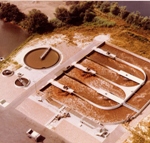
Incorrect Application of the BOD Test
- By Peter Maier
- Jun 07, 2010

The two waste components of sewage are carbonaceous (fecal) and nitrogenous (urine and protein). Fecal waste feeds heterotrophic bacteria, which causes a carbonaceous biochemical oxygen demand (C-BOD), while urine and protein are picked up by autotrophic bacteria, resulting in a nitrogenous demand or N-BOD. The latter also can be measured with the Total Kjeldahl Nitrogen (TKN) test.
The original technical literature assumed that, during the first five days of the BOD test, only heterotrophic bacteria are active and that the average strength of raw sewage has a BOD5 value of 200 milligrams per liter (mg/l) with a TKN value of 40 mg/l. The total BOD exerted by raw sewage, if discharged into open water, is 1.5 x 200 (300) + 4.6 x 40 (184) = 488 mg/l and not 200 mg/l as some still think.
This is well described in any older textbook or from the U.S. Geological Survey (pdf). Unfortunately, when regulations were initiated, many assumed that the oxygen required to stabilize all organic matter in sewage was equal to the BOD5 value or 200 mg/l, thereby ignoring not only part of the oxygen required by heterotrophic bacteria, but all of the oxygen required by the autotrophic bacteria. This was and still is commonly done in most countries.
The Clean Water Act sought to eliminate all pollution by 1985, which had to be achieved by demanding best available sewage treatment. Since "complete" or 100 percent treatment was not economically feasible, Congress settled for "secondary treatment," which was considered to be equal to 85 percent treatment. With the assumption that raw sewage contains 200 mg/l BOD5, the U.S. Environmental Protection Agency in 1972 used the BOD5 test in its definition of secondary treatment and set the BOD5 effluent standard at less than 30 mg/l (85 percent of 200), without realizing that the BOD5 test only represents 40 percent of the total BOD. In fact, instead of demanding 85 percent treatment, EPA actually settled for 34 percent (85 percent of 40 percent = 34 percent) BOD treatment in its NPDES (National Pollution Discharge Elimination System) permits.
That the autotrophic bacteria are not active during the first five days may be valid for very fresh sewage, but it is not valid when the test is applied on sewage exposed to nature and on treated sewage. Many plants in the '70s violated their permits because of high BOD5 test readings, while in many cases (60 percent), this was caused by the fact that a large portion of the BOD5 test reading was N-BOD5, a pollutant not required to be treated.
In 1984, EPA acknowledged the problems caused by the BOD5 test and, by administrative rule, allowed the use of C-BOD5 test. This inhibited test adds a special chemical that kills autotrophic bacteria so that they do not contribute to the test result. This administrative ruling not only lowered treatment from 100 percent to a measly 34 percent BOD treatment but also officially ignored all the water pollution caused by nitrogenous waste. This actual human waste (urea, amino acids, ammonia, and nitrates) not only exerts an oxygen demand (N-BOD), but it also is a fertilizer for algae growth that contributes to eutrophication, causing dead zones and red tides.
The only correct application of the BOD test is:
Total BOD = 1.5 x C-BOD5 + 4.6 x TKN
In 1993, local environmental groups and I petitioned EPA to modify its secondary treatment requirement as it is technically feasible and suggested the following:
C-BOD5 less than 15 mg/l
TKN less than 5 mg/l
NH3-N less than 1.0 mg/l
NO3-N less than 5 mg/l
Total P less than 2 mg/l
(All measured over 7-day averages, representing better than 90 percent BOD treatment.)
Compared to present treatment requirements, this seems very strict, but these values can be achieved easily using simple oxidation ditch processes, with the additional advantage that, due to its long solid retention time, disinfection is not necessary, eliminating cost and such issues as carcinogenic disinfection byproducts.
Incorrect BOD testing sadly is not the only problem as most of the engineering used to design and built new sewage treatment plants, is based on tradition. A tradition that, during the past century, was solely focused on the prevention of nuisances, while not recognizing that sewage is an essential part of the natural element recycling processes of carbon, hydrogen, oxygen and nitrogen, which are the basis of all biological life on Earth.
Canada is considering new regulations and requires an effluent C-BOD of less than 25 mg/l, (the U.S. C-BOD5 limit is 25 mg/l) while again ignoring N-BOD and the fact that nitrogenous waste is a fertilizer and increasingly a major problem. Hopefully, the Canadian authorities will bite the bullet and correct this essential water pollution test so we finally will know how sewage plants operate and what their effluent waste loadings are on receiving waters.
About the Author
Peter Maier, Ph.D., P.E., has been speaking against the incorrect use of BOD since 1983. To learn more, visit www.petermaier.net.